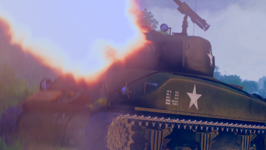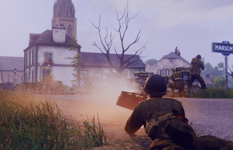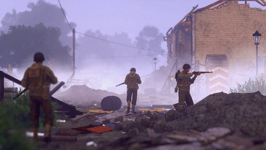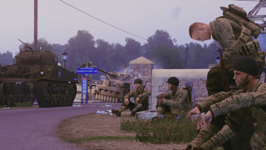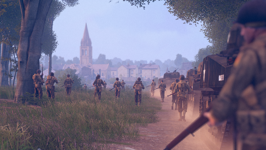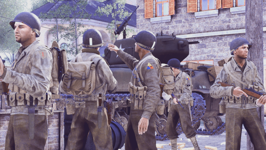Many years ago we started out 'Report In!' interview series to tell you a bit more about the behind-the-scenes of game development. With the newest Creator DLC (Spearhead 1944) about to be released (July 25), we felt it would be a good time to question some of the third-party developers from the Heavy Ordnance Works team. This special 'Report In!' gives you a more personal perspective and a more detailed look at the way they go about their work.
INTRODUCTION
Tell the people a little about yourself. Who are you, and what do you do?
Ben Shimadry - I, like many, fell into the Arma series through the DayZ mod in Arma 2, then grew into terrain making for Arma 3, and then somehow sold my soul to the CUP team. Outside of Arma, I like playing various games, but I’m particularly drawn to anything with a space or sci-fi setting. I am one of the Creative Directors within Heavy Ordnance Works (HOW) for the Terrain and Object departments.
Michael Cochrane (Instant Muffin) - I’m a Mechatronics Engineer that started with Arma 2, having a great time in public domination servers. I also played the DayZ mod and Arma 3’s Alpha, but it wasn’t until around 2014 that I got completely hooked on the MilSim community, playing with an Australian unit for years. With them, I picked up modding on my own for a while before joining the Iron Front Arma 3 (IFA3) team to help with vehicle and weapon implementation. There I learned a lot and eventually landed the position of Creative Director for the HOW Assets team. 3D art for games is something I’ve come to really enjoy with Arma modding, and the CDLC is an amazing outlet and chance to develop these skills.
Markus Esser (Bob Murphy) - Outside of Arma 3, I am back to university after some years of work to get a master’s degree and have a background in Food Production Engineering, as well as business development and some online marketing. In terms of Arma, I got hooked in 2016 when I found my way to the Antistasi community. In early 2019, I founded the Antistasi Community Dev Team, which is still active and alive these days. Due to that, I was happy to get into Savage Game Design in December 2019, where I was first a tester and Community Developer and then later was QA Lead for over one and a half years. In mid-2022, I was approached and asked if I would be interested in helping as QA Lead with Spearhead, which I happily accepted. Over time my areas of responsibility grew, and now I’m more of a general Producer, helping all teams and Creative Directors where possible.
What is your favorite BI game or Arma mission?
Ben: With Steam telling me I have almost 10 thousand hours in it, I would probably have to go with Arma 3. I have a particular soft spot for the first chapter of the East Wind campaign, as well as enjoying the Contact campaign.
Michael: I’m always going to have a soft spot for Arma 2 since it’s where I started, but I think the real answer has to be Arma 3. I wouldn’t even know where to start picking a favorite mission - there have been so many incredible ones over the years. There’s no other game that can give the co-op experience that Arma can.
Markus: Certainly Arma 3, but it’s more because of the whole community and overall experience rather than any single mission. When I’d have to pick a mission, I’d go with the Contact campaign.
Can you give us some random facts about yourself?
Ben: The first video game I ever played was Theme Hospital when I was six. I would choose dogs over cats. I do not like mushrooms.
Michael: I helped design and build an electric race car at university while taking full-time classes and working on the IFA3 mod at the same time for two years. This was incredibly stressful and not the smartest idea I’ve ever had.
Markus: I really do drink an average of 2 liters of coffee per day.
MARCHING IN
How did the Spearhead 1944 project start, and how did you start forming your team?
Markus: The Spearhead 1944 project started with a few guys from the IFA mod. After working on the mod, lots of discussion about other games, storytelling, and related topics formed the general idea of the project. Over time goals and boundaries were set, which led to a particular project scope that strived for quality and quantity which wasn’t realistically achievable in a mod. As the initial team was too small for the intended scope of the project, they approached modders from different modding teams, individual developers who created and published assets on their own, and people within other Creator DLCs to join the team, especially World War II (WW2) related ones. This is how I got into the team, for example.
This natural process led to the current team, which is looking forward to finally sharing what they have worked on for years. This team is very different in terms of roots within the Arma community and stems from all over the world. However, it is very connected by their shared interest in telling the story of Operation Cobra and their ambition to create something the players will enjoy.
What made you choose this particular setting?
Michael: Many of us are personally interested in developing World War II content. Our team has grown over time, but we didn’t have the time or resources to develop everything we would have liked to. We decided to focus on one battle and develop it to the best of our ability while providing as much new content for the players as possible.
Operation Cobra is a comparatively not well-known part of the Liberation of France but had a major impact on the result of the operation as a whole. It was a difficult battle with fairly high stakes for the Allies if it went wrong. Still, it's often overlooked, making it a good candidate for approaching a familiar setting that isn’t exactly what people have seen a dozen times before in games. It also introduces interesting gameplay challenges with the bocage covering the terrain, as it did in reality. The focus on the 2nd Armored also allowed for additional customization options as they were one of the American units that made use of camouflage on both their vehicles and uniforms during this period.
How has the inclusion of long-standing veterans and members of the Arma community within your development team positively impacted the overall quality, authenticity, and player experience of the Creator DLC?
Markus: It certainly helped a lot and can not be understated. There are so many bright minds within the Arma community, of which many are either active and reachable on the Arma 3 Discord or happy to help out via direct message. I never had much to do with these exchanges besides facilitating a few contacts, but I know that there have been quite a few chats, calls, and meetings with people from all over the community to get their judgment, opinion, and technical expertise - often with them not even knowing what project the question was for.
Thank you very much to all you wonderful people out there that helped us along the way!
How has your project benefited from being a Creator DLC?
Ben: I think one of the biggest benefits is the team took what would normally be considered modding and elevated it to a professional standard, and has given them a platform that could help with finding other work or a career in the industry.
BATTLE PLANS
There is a lot of connection to historical events in Spearhead 1944. How did you conduct your research for this project, and how significant was historical authenticity while making this CDLC?
Markus: In total, we had more than a handful of historical researchers and advisors, of which most had a particular specialty. While one did extensive research on the location of Operation Cobra, the bocage, and the rivers, another focused on the vehicles and so on. Their work cannot be understated. For example, prababicka produced a 50-page reference document that was used throughout the project. We do strive to tell a story based on and inspired by real events and people, which sometimes gets a bit overlooked next to the other large theaters of war, and to be able to do that, getting as close to the real history as possible was a non-negotiable goal.
Sure, we can not be 100% accurate and will never claim so; that is simply impossible. But we endeavor to do our best and be as authentic as possible.
Did you face any challenges in maintaining both gameplay and historical accuracy, and how did you strike a balance between the two?
Ben: With respect to the terrain, there was often a balance to be found when designing “travel areas” between settlements and other points of interest. We found that in some areas of our reference terrain imagery, the agricultural composition of the area was quite bland. There would, at times, be nothing but crop fields for hundreds of meters, which didn’t always allow us many options for creating different styles of gameplay within those areas.
We found that there was often a choice between when to keep to the historical photography and when to make some changes for the sake of gameplay, such as swapping out some specific crop fields for orchards to provide infantry with some concealed approaches. In the opposite vein, sometimes we merged multiple smaller fields into a few larger fields in areas to better allow for vehicle gameplay with more medium-length sightlines. Ultimately we are making content for a game, so the gameplay experience has to come first. Sometimes breaking from the historical reference is needed in order to give you the flexibility to stick to your gameplay design goals.
How did you go about selecting the weapons and vehicles in your package?
Michael: We wanted to provide as complete a WW2 experience as we could while still providing new content that players can’t find in the various existing WW2 mods. Many vehicles from the period are very complicated due to the prevalence of open-top or casemate vehicles throughout the war, making them difficult to model and implement. As a result, these aren’t too common to see in the community, especially on the US side, despite being standard vehicles in reality. So we took the opportunity of this CDLC to provide some, namely the Sd Kfz 250/1, M3 Halftracks, M10, M18 Tank Destroyers, and Nashorn. When it comes to weapons, I think there’s an expectation of what a WW2 package would provide, so we tried to include as many of the common weapons as possible while adding some rarer but enjoyable additions like the flamethrowers.
Much of the team has come from many parts of the WW2 Arma community, and as a result, we’re conscious of some of the difficulties that come from trying to build missions in this setting. With certain mod combinations potentially lacking capabilities such as anti-tank or anti-air guns for particular sides, we wanted to begin addressing this as well.
Can you describe the process of developing the Normandy terrain? What were the key considerations and challenges involved?
Ben: We started by looking at how large the area Operation Cobra covered, finding that it was all-in-all quite an expansive area, easily covering 50km by 50km, which was not practical to do in Arma. After picking a portion of the operation area that had fighting by the same divisions at multiple locations that the campaign team could explore, we decided that with the resources available, it would make the most sense to scale the area down by half. This led to a “real” area of approximately 24km by 24km being shrunk to 12km by 12km for the in-game version of the Normandy map.
From there, it was a case of cutting the terrain up into sectors and assigning sectors to each of our environment artists to start building the appropriate features with the aid of historical aerial photography of France from shortly after the war. However, we first established some core design styles, such as forest construction, hedgerow designs, and orchard compositions, to ensure a level of aesthetic consistency between the different artists when producing the same features.
Early on, an element that we knew was going to be a particular hurdle to overcome was the many rivers that exist within our map. Given that the terrain did not sit at sea level and there was not a feasible way to fake it to do so, the rivers would have to be placeable objects. It took many months to make the objects in the first place and to get them placed on the terrain efficiently and seamlessly. Luckily with the help of HorribleGoat and what can only be described as “blender wizardry,” we ended up with an implementation that is not only very pleasing visually, but is functional with both the players and AI. Overall the rivers were definitely the largest technical challenge during the making of the Normandy terrain.
How did you approach the design and creation of the cooperative campaign in Spearhead 1944?
Markus: We focused on delivering the best, large-scale, cooperative campaign that we possibly could, inspired by actual events. We spent many days looking at movies, older Arma titles and other games, historical material, Steam, Workshop content, and other CDLCs for Arma 3. While simultaneously writing down the pros and cons of what we found. By the end of that process, our path forward was clarified. We started breaking down Operation Cobra, dividing it into the mission concepts and later adjusting them to the game limitations. We quickly established what we wanted to achieve regarding gameplay, narration, and overall atmosphere. We knew we not only wanted to deliver a highly customizable and replayable campaign but also to convey the chosen theme's historical background and significance. Looking at things from this perspective, this all was very ambitious for a small team but with the dedication of many hard-working people, we achieved our vision.
Every mission in our campaign starts with an animated situation report. The key idea is to give players a broader perspective of Operation Cobra, the context behind its phases, and ideas for our community mission makers to devise scenarios that would accompany our campaign. We wanted to create an immersive, historically authentic, and entertaining experience. While it sounds relatively simple, balancing those three values can be extremely challenging.
Deciding on what bit of information to present and what to leave out is especially difficult when you are aware that there are hundreds if not thousands of real people’s lives behind every word in battle journals and daily frontline reports. We did our best to respect those who paid the highest price, yet it is just a speck in the great tragedy of the Second World War.
A massive amount of work went into the creation of animated SITREPs. During the process that took over 12 months, we consulted with private collectors of colored WW2 slides and photographs. We came up with filters and image manipulation techniques to make in-game screenshots look as authentic as possible.
An opportunity to have hands-on experience with 1940s film and slide projectors and observe their peculiarities helped us to mimic that experience in a virtual environment. We dug deep into archives of aerial reconnaissance images to try and recreate them in the best yet accessible way. On board with us was a professional graphic designer bringing her typography expertise to develop a handwriting style that would fit the historical context.
And on top of that, of course, miles of WW2 film were watched, and thousands of pages of battle reports and maps were carefully investigated. We really hope that our work fulfills its main function: to bring an immersive, historical experience within the Arma universe, and to pay our respect to those who fell in that war.

Example of the storyboard process used for creating the intro and outro campaign cinematics.
What criteria do you use to determine when something is considered complete?
Markus: There are a multitude of criteria that are different based on what type of asset we are talking about, be it a weapon, vehicle, backpack, terrain, campaign, cinematic, or something else. Hence this is not a question that can really be answered easily. Things we are overall determining are if all the game mechanics/features are implemented and working as expected, if the visual design is on par with our standard and comparable with the other assets, if the effects and the audio design are implemented and give the additional depth they can bring to the table. On top of that we have to keep in mind that what we create works with the storytelling we are aiming to deliver, especially in the campaigns, cinematics, teasers, and trailers.
When it comes to the campaigns and the co-op mission, we look at the game pacing and the player engagement. We try to provide multiple options, in-game and via parameters, so that players can change the difficulty and pace to their liking, choose different approaches, and discover new ways to achieve their goals.
To be completely honest, nothing is ever fully complete. But if all the boxes we have are ticked to a more than satisfactory level, we determine the content is ready to be released.
FROM THE FRONTLINES
What would you say has been the most challenging thing about developing Spearhead 1944, and how did you overcome it?
Ben: For me, it has been juggling resources, especially people and time. Sometimes key artists have to step away for personal reasons, or sometimes implementing a set of models or functionality hits a speed bump and takes longer than budgeted. More often than not, there is a little too much to do and not quite enough hands to get it done. But each time we adapt - sometimes that is moving assignments around to different artists or identifying where aspects of a workflow can be streamlined to help get things back on track.
Michael: Much like Ben, the hardest challenge is managing people and time, especially with a project of this type where it’s not exactly everyone’s primary job. Deadlines get missed, people don’t end up having the time they thought they would, some lose motivation for a while, and certain events of the last few years took their toll. At the end of the day, communication is important, and understanding the various situations of each member of the team matters. There was a need to adapt, talk through the problems, look at the available resources, and find a way forward.
If there's only one thing you could point out that you are the proudest of, what is it and why?
Ben: The signpost network, which probably sounds strange and is something that is initially overlooked by a lot of players, but it took an unexpectedly large effort to complete. It took Dmitry Yuri and myself a total of five weeks to design and create a system with rules to: identify where signposts should be placed, how many pointers each one needed to have, what each pointer needed to say on it, and what distance needed to be printed on that sign. Then we had to create the models for 338 directional signposts on our terrain. Adding further complexity is that many of our “French” style signposts also have a road number on them, which are accurate to the real versions of those roads. All-in-all it should allow players to navigate to most of the locations on the terrain with only a compass and street signs.
Michael: I really love our set of gameplay enhancements. The additional audio and vehicle damage details give a very immersive experience when playing in and around armor, making it much more worth using the right anti-tank weapon and aiming your shots. Pushing and towing added a new type of gameplay to the game, making anti-tank guns feel more practical and not like they’re stuck in place. Hip fire makes machine guns feel significantly different to use than regular rifles. The additional reload animations change weapon handling, making it worth thinking about when to reload instead of always emptying a magazine. Everything works together to make the game feel like a bit of a different experience.
What type of experience do you hope players will get from playing this CDLC?
Michael: I really hope players enjoy the campaign. The hedgerows provide a unique experience and make things feel claustrophobic in a different way than something like the jungles of Tanoa might. I also hope the new weapons and vehicles we’ve provided improve the experience of their own custom mission designs.
Markus: My hope is that players will get a renewed taste of Arma 3 and not only enjoy the campaigns and missions we created but also try the community game modes, which have already been created and will be released shortly after Spearhead’s release. There is much to discover and explore; many of the concepts have a high replayability and I hope there will be many sleepless nights with play sessions, events, and people just having fun with the content we created.
GENERAL QUESTIONS
After a long day of work and creating new Arma 3 content, what do you like to do to relax and unwind?
Ben: Usually playing a game, depending on just how tired I am, it might be something mindless like Battlefield, or if I am still pretty alert, then watching my colonists harvest some organs in RimWorld will always be amusing.
Michael: I’ve been playing games the majority of my life, so that’s usually the way. Many hours were spent in Final Fantasy XIV, RimWorld, Halo, etc. But “relaxing” often ends up with modeling software and a few dozen browser tabs with references open again working on side projects.
Markus: My downtime is mostly filled with other projects which I like to work on. My main hobby project is still Antistasi, where I am working with an incredible team. There are a few smaller projects, but they change quickly and aren’t noteworthy.
What would be your top tip for other developers out there?
Ben: Have a plan. Stick to the plan and adjust if you run into barriers, but stick to it. Without a plan, it becomes too easy to get sidetracked or procrastinate without a clear direction and goal to be working towards.
Michael: Be prepared for anything and everything to go wrong. Expect everything to take longer than it should. If you think something is a small job, it probably isn’t. Most of the work is what you think is the last 10 percent.
Markus: For your own sanity, make backups, where applicable. Use source code management like GitHub or GitLab and surround yourself with people you can learn from and ones that critique you honestly and openly. Don’t work in a bubble but strive to learn, improve and grow with what you do.
If you were an intrepid fedora-wearing archeologist, and you discovered a horde of treasured video games that are about to be lost forever, which one game do you save to be placed in a museum?
Ben: Mount and Blade: Warband. Many fond memories with that one.
Michael: Gotta be Halo 3. Many an hour spent in custom games with friends.
Markus: Factorio - a small and harmless management simulation game you certainly will not get hooked on and play for at least 36 hours without breaks.
The Arma 3 Creator DLC: Spearhead 1944 will release July 25, 2023 and can be wishlisted now on Steam!





